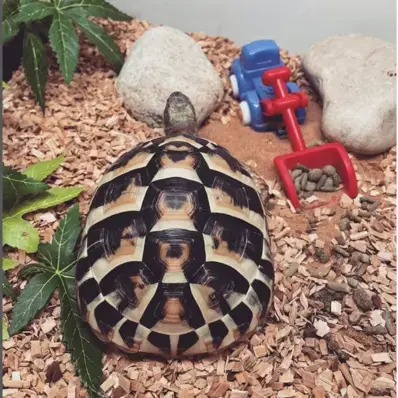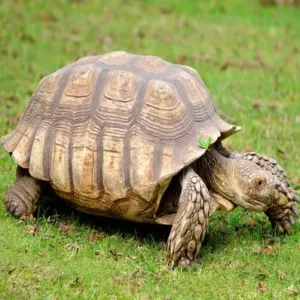History/Origin
The Greek Tortoise boasts a captivating history deeply intertwined with ancient civilizations. Originating from the Mediterranean region, these resilient reptiles played a significant role in the lives of Greeks and Romans. Revered for their symbolism of longevity and tenacity, Greek Tortoises were not merely kept as pets but also revered as symbols of endurance and wisdom.
Historical records reveal their presence in various aspects of ancient culture, from artwork to literature, underscoring their cultural significance. The enduring companionship between humans and Greek Tortoises echoes through time. It makes them not only pets but an enduring symbol of classical civilizations and the timeless connection between humanity and the natural world.
Greek Tortoise Subspecies
Greek tortoises encompass several distinct subspecies, each with unique characteristics and distributions.
Here are the main subspecies:
Testudo graeca graeca: Found in northern Africa, this subspecies is known for its smaller size and distinctive shell patterns.
Testudo graeca ibera: Native to the eastern Mediterranean, these tortoises are larger with flatter shells and are popular in the pet trade.
Testudo graeca terrestris: Inhabiting the Balkans, this subspecies is characterized by its robust build and varied shell colors.
Personality
Greek Tortoises are known for their calm and gentle nature. Despite their slow movements, they exhibit curiosity and can form bonds with their owners. They thrive on routine and may display a degree of independence. As solitary creatures, they appreciate a quiet environment.
Physical Appearance
Let’s take a closer look at the physical traits of the Greek Tortoise.
- Size: Typically small to medium-sized, Greek Tortoises have a shell length ranging from 5 to 8 inches.
- Color: Their domed shell features intricate patterns in shades of brown and yellow, providing camouflage in their natural habitat.
Gender Differences
Distinguishing between male and female Greek Tortoises involves subtle yet distinct characteristics.
- Size: Females of Greek Tortoises are typically larger and more robust compared to males.
- Plastron: Males usually have a slightly concave plastron, aiding in stability during mating, while females have a flatter plastron.
- Tail: Males generally have longer and thicker tails with a noticeable vent opening, while females’ tails are shorter and smaller.
Greek Tortoise Feed and Nutrition
Explore the dietary preferences and nutritional requirements of these reptiles here.
Greek Tortoise Diet
- Leafy Greens: Offer a variety of leafy greens, such as kale, collard greens, and dandelion greens. These provide essential vitamins and minerals.
- Vegetables: Include a mix of vegetables like carrots, bell peppers, and squash for added nutrients and fiber.
- Fruits: Offer fruits in moderation, such as strawberries and melons, to provide natural sugars and additional vitamins.
Calcium Supplementation
- Importance: Greek Tortoises require a calcium-rich diet to maintain shell health and prevent metabolic bone disease.
- Sources: Dust food with calcium supplements or provide access to calcium-rich items like cuttlebone.
Access to Clean Water
- Hydration: Ensure a shallow water dish is available at all times. Greek Tortoises need access to clean water for hydration and to aid in digestion.
- Avoidance of Toxic Foods:
- Toxic Plants: Be cautious of toxic plants like rhubarb and certain cacti. Research safe food options to prevent harm.
- High-Protein Foods: Limit high-protein foods as they can lead to health issues in herbivorous tortoises.
Seasonal Variation
- Temperature Impact: Adjust the diet based on seasonal variations. During cooler months, tortoises may eat less, so monitor their appetite and adjust accordingly.
- Hibernation Preparation: Gradually reduce food intake in preparation for hibernation, mimicking their natural behavior.
Health
Greek tortoises are prone to specific health issues. Here are some of the health concerns they face during their life span:
Vitamin A Deficiency
- Cause: Inadequate intake of vitamin A-rich foods.
- Symptoms: Swollen eyelids, nasal discharge, lack of appetite.
- Prevention and Treatment: Provide a varied diet with leafy greens and ensure proper supplementation.
Beak Overgrowth
- Cause: Insufficient wear on the beak, often due to improper diet or lack of appropriate surfaces for grinding.
- Symptoms: Overgrown beak, difficulty eating.
- Prevention and Treatment: Offer a variety of textures for natural beak maintenance. Regular beak checks and trimming if necessary.
Nutritional-Secondary Hyperparathyroidism (Metabolic Bone Disease)
- Cause: Inadequate calcium and vitamin D3, leading to weakened bones.
- Symptoms: Softening of the shell, limb deformities.
- Prevention and Treatment: Ensure a diet rich in calcium, and provide access to sunlight or UVB lighting.
Respiratory Infections
- Cause: Inadequate temperature, humidity, or poor habitat conditions.
- Symptoms: Labored breathing, nasal discharge, lethargy.
- Prevention and Treatment: Maintain proper environmental conditions, and seek veterinary care for respiratory issues.
Reproductive Problems
- Cause: Incorrect conditions, stress, or inadequate nutrition.
- Symptoms: Difficulty laying eggs, egg retention.
- Prevention and Treatment: Provide suitable nesting sites, monitor stress factors, and ensure proper nutrition.
Shell Rot
- Cause: Fungal or bacterial infections due to damp conditions.
- Symptoms: Soft spots on the shell, foul odor.
- Prevention and Treatment: Keep the habitat clean and dry, and address any signs of infection promptly with veterinary care.
Greek Tortoise Care and Grooming
- Greek Tortoise Enclosure: Design a spacious, well-ventilated indoor or outdoor space with secure fencing.
- Sunlight and Basking: Provide natural sunlight and a designated basking area with a heat source.
- Hiding Spots: Include rocks, logs, or plants for security and stress reduction.
- Grooming for Health: Conduct routine health checks, inspect the shell, and maintain habitat hygiene.
- Diet Monitoring: Ensure a balanced, varied diet, and provide access to clean water.
- Environmental Enrichment: Stimulate the environment with objects and rotate accessories for mental engagement.
- Veterinary Care: Schedule regular check-ups and follow a parasite prevention program for overall well-being.
Rescue Groups
Various reptile rescue organizations and shelters specialize in the care and adoption of Greek Tortoises. Adopting these groups ensures responsible pet ownership and helps support conservation efforts.
Species for Sale
Reputable breeders or exotic pet stores may offer Greek Tortoises for sale. Ensure proper documentation and inquire about the tortoise’s health history before making a purchase.
Interesting Facts
- Longevity Record: Greek Tortoises can live over a century, with some individuals reaching 150 years old.
- Temperature-Dependent Sex: The incubation temperature during nesting determines the gender of the hatchlings.
- Digging Experts: Known for their exceptional digging skills, Greek Tortoises create burrows to escape extreme temperatures.
- Unique Shell Patterns: Each tortoise has a distinct shell pattern, much like a fingerprint, making them individually identifiable.
- Ancient Symbolism: Revered in Greek mythology, the tortoise symbolizes patience, wisdom, and protection, embodying the spirit of Hermes, the messenger god.
Best For
Ideal for individuals seeking a low-maintenance reptilian companion with a long lifespan, Greek Tortoises are best suited for home pets. They thrive in the care of responsible reptile enthusiasts willing to provide the necessary attention and a suitable habitat.
As a captivating and long-lived species, they make excellent companions for those looking to share their space with a fascinating and enduring reptile.
Top Names
| Male Greek Tortoise Names | Female Greek Tortoise Names |
| Apollo | Athena |
| Zeus | Hera |
| Titan | Artemis |
| Odysseus | Aphrodite |
| Hercules | Gaia |










